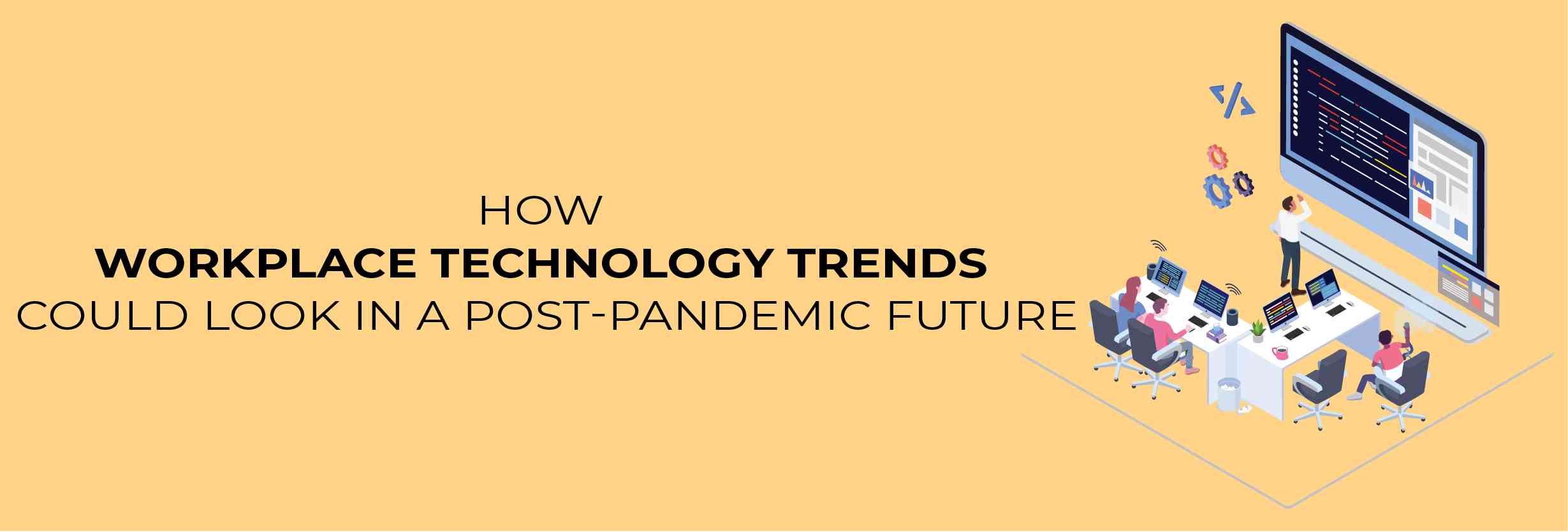How Workplace Technology Trends Could Look Like In A Post-Pandemic Future
In light of the countermeasures adopted worldwide to prevent the further spreading of COVID19, there has been a profound impact on all walks of life. With the practice of social distancing, businesses are putting into place work-from-home processes and laying out back-to-work strategies.
Companies will be adopting various trending technological workarounds to resume 100% productivity and remain responsible to employees and society.
What would returning to work look like? Some organizations are completely committing to remote work, promoting the idea of work from home culture. Others are changing floor plans, confining the workstations. And some are implementing staggered work shifts. While a company can choose from any preferred workplace trends, keeping things normal post-pandemic will certainly be a challenge.

The impact of the novel coronavirus pandemic has disrupted every human life on the planet. The economy is down, and unfortunately, some companies have succumbed to the situation, shuttering down the doors of their business for an undetermined period. Businesses need to understand that technology will play a significant role in reviving their operations and help them deliver uninterrupted service.
Let us take a look at the workplace technology trends that are going to be a normal sight in the post-pandemic future.
Introducing remote work
Business executives will agree that exploring workplace technology trends will strengthen a successful organization. However, they never really wanted to look into the plumbing. That's all changed in the last couple of months, thanks to the COVID-19 pandemic that has put the whole world into lockdown. In the wake of the pandemic, technology matters to everybody in the industry more than ever before.
Employers, managers, and teams who never entertained video-conference calls previously, now spend the majority of their working hours on Skype or Zoom. While managing the whole workforce virtually throughout the day seems to be daunting, they are thankful for the fact that they can.
Remote work has become the norm. It has been both a bane and boon for people. Some people find that working from home has really compromised their ability to stay disciplined and productive while others are glad to be able to spend their whole day with their family and save on time and cost of commute.

Remote work is enabled by work collaboration tools, cloud technology, virtual meetings, voice over internet protocols (VoIP), virtual private networks (VPNs), and even facial recognition. All these technologies enable having a virtual workspace.
This sudden switch to remote working has forced the businesses to rethink their status when it comes to digitization. It has forced industries to find workarounds and sustain an uncompromised form of conducting business.
Industry experts believe that this will likely lead to businesses implementing new workplace trends that can enable remote collaboration in a more effective manner. The sooner they become familiar with the latest technologies, the quicker and easier it will become for the workforce to adapt to the new situation.
The pandemic has opened doors to monitoring and collaboration technologies that can play a vital role in shaping the post-pandemic workforce culture. The use of mass collaboration infrastructures can lead to a normalization of some highly intrusive tools, resulting in the hasty introduction of devices and applications that are going to be present in the long term.
Amidst all of this, businesses are walking a thin line between protecting their privacy and keeping people safe. The absence of any clear guidance may lead to data loss, which can lead to disastrous consequences.
The Workplace of the Future

It is difficult to say where the chips will fall but one thing is for certain. Things will not return to how it was before the COVID-19 pandemic.
Touchless Offices - A New Normal
Employees and teams are already using technology in a unique way to facilitate their needs. With the adoption of business communication applications, data exchange and collaboration have become quite easy. Tools like Google Docs and Dropbox are now being used more than ever, especially by content creations companies such as essaywriter and others. The building automation industry, on the other hand, is positioned to help facilitate a healthy workplace. How people interact with their environment and how they utilize space is of utmost importance. Standards of indoor air quality and fresh air will certainly come to the forefront.
According to ASHRAE, a minimum range of 15-20 cfm (cubic feet per minute) of fresh air is required for an individual in an office space. However, fresh air will not mitigate infection points. This is where the concept of touchless offices emerges because just taking care of ventilation and clean air isn't enough to mitigate or prevent the next pandemic.
Common-use appliances, AV remotes, and door handle - all are major carriers/hosts of the virus. With that said, one of the biggest workplace trends will be the separation of technologies in buildings. It comes as no surprise that equipment and building automation systems that people use in the office environment will be separated. However, will it solve the problem?
In an office environment, boardroom access is completely automated and is booked via proprietary software using a desktop or laptop computer. Lighting is adjusted using common dimmers and switches. Temperature is controlled using a wall thermostat. AV equipment is manually operated using a remote controller. Automatic blinds are operated using touchpads or remotes. All these are potential infection points, and they are all used by multiple individuals on a daily basis.
The idea is to make them more commonly integrated rather than separating them. This is because as long as their access remains separate, they will remain the potential infection points.
Integrating them will require the proper and conceptual use of the networks. IP communication is expected to play a big role here. As a result, building automation systems will become the central communication hub for workplaces. Employees can book boardrooms or meeting rooms via proprietary booking applications, which could be connected to the building automation system.
Furthermore, automatic blinds, AV equipment, lighting, and more all require simple wireless protocols. With these systems integrated together, one can easily carry out the operations while lowering the spread of infection. Nevertheless, this still doesn't eradicate all the touchpoints. But it is a start, and technology (IP communication) will play a significant part here.
The Norm of "Click and Mortar" Businesses
The current pandemic has caused some serious trouble for brick and mortar businesses, following the quarantine measures ordered by the world governments. In order to operate and thrive, a new concept of 'click and mortar' has been introduced as an alternative to the traditional business model.
Click and mortar is just like your e-commerce sector, but the only difference is that the business will incorporate both offline and online operations. The stores, shops will be open for those who wish to come to physical stores and buy their essentials. On the other hand, these businesses are expected to have an online platform for those who prefer buying things online from the comfort of their homes.
Although this concept has already been implemented a long way before COVID-19, it will be more flourished in the post-pandemic world.
As the fear is real, people will refrain from going to crowd-gathering places. In the future, brick and mortar businesses will see adapting to seamless application development services that will allow people to access the business via streamlined mobile apps.
The Future of Work Trends Post-Pandemic
According to Gartner, the post-pandemic world will bring new workplace trends regarding employee tracking, gig workers, remote working, and health support. This is a time where businesses are experiencing large-scale shifts. As per the reports, 48% of employees are expected to work remotely post the pandemic, as compared to 30% before the pandemic.
This is a clear indication that businesses do not want to put employee health at risk. Hence, they will be prioritizing collaboration and networking tools. This may influence how the workforce is evaluated and how it will affect their management and performance. Employees have realized the need for upskilling after seeing businesses taking a big step to cut costs by replacing full-time employees with contingent workers.
In the midst of all this, the workforce's financial health and mental health will become prominent. It will be interesting to see how the organizations will take a step in this direction.
Check out our workshops if you're looking to boost your career.
